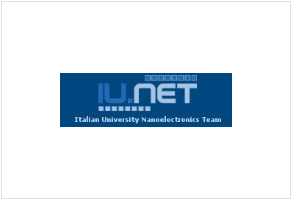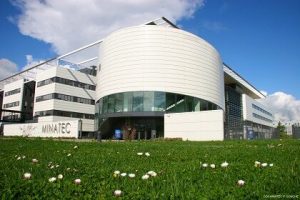Italian University Nanoelectronics Team
Contact persons:
Luca Selmi, Enrico Sangiorgi, Danilo Demarchi
Via Toffano, 2 –
40125 Bologna
Italy
The National Interuniversity Consortium for Nanoelectronics (IU.NET) consists of 11 Italian Universities active in the field of Electronic Technologies and, in particular, physics, modeling, characterization, design and reliability of micro- and nano-electronic components for digital and analog applications, optoelectronic and power devices, sensors and biosensors, renewable energy production facilities, energy harvesting and energy storage. The consortium units are the Politecnici of Milan and Turin and the Universities of Bologna, Calabria, Ferrara, Modena and Reggio Emilia, Padua, Perugia, Pisa, Rome “La Sapienza” and Udine.
Processing platform
University of Bologna
- Windows/Linux PC workstations
Politecnico of Milano
- PoliFab fabrication facility (http://www.polifab.polimi.it/) equipped with optical lithography, electron beam lithography, wet and dry etching, thin film deposition ellipsometry.
University of Padova
- Advanced Package Rework System that ensures both accurate component placement and custom tailored reflow profiles in a single platform rework system.
- Soldering/de-soldering stations (Metcal, JBC, Weller)
- Inspection microscopes: Ash Inspex HD 1080 p Digital microscope, Vision Engineering Lynx Stereo inspection microscope, Dino-lite digital microscopes, Weller microscope
- Thermocamera Flir A20
University of Perugia
- Clean room (30 square meter, 100 class under laminar air-flow) for electronic circuit production and assembly, including a complete process line for the realization of flexible circuits exploiting the copper-laminate method, so far used successfully up to 24 GHz
University of Roma
- 3 chambers PECVD for a-Si:H deposition; Microwave CVD for silicon nanostructure growth, RF-CVD for carbon nanostructure growth, chemical laboratory; “clean room” class 10000; Evaporator; RIE; Mask aligner; UV Photolitography
Modelling platform
University of Modena and Reggio Emilia
- Cadence analog and digital circuit simulation tools
- COMSOL Multiphysics, Sentaurus TCAD device simulation tools
- MDLab software Ginestra for characterization and reliability assessment
University of Bologna
- EDA tools for IC design (from Europractice subscription):
- Cadence IC and Systems packages
- Synopsys Front end and Verification (FEV)
- Sentaurus TCAD
- Mentor Full Suite
- In-house developed optical simulator
- FEM multiphysics tool used for piezoelectric sensor and solid mechanics simulations (transient and stationary) and thermofluidic analysis (transient and stationary)
- Simulation of nanoelectronic devices using in-house developed tools coupling Poisson equation and transport (time-dependent solution of Schroedinger equation, full quantum with QTBM or NEGF methods: EM, k.p or TB Hamiltonians, semiclassical Boltzmann transport equation through deterministic methods
University of Calabria
- Cadence analog and digital circuit simulation tools
- Sentaurus TCAD device simulation tools
University of Milano
- Comsol Multiphysics (MEMS sensors, photodetectors, etc…)
- Matlab/Simulink (behavioral models)
- Cadence (integrated circuits design)
- Labview (test setup design)
- Synopsys (device simulation platform)
University of Padova
- ORCAD Pspice and PCB layout
- SIMetrix/SIMPLIS Pro
- PLECS with Matlab/Simulink
- CAD frameworks for digital, analog and RF/mm-wave IC design (Cadence, Synopsys, Mentor, Keysight)
University of Perugia
- ADS (Keysight), CST
- Synopsys Advanced TCAD Suite (TCAD)
University of Roma
- 2-D and 3-D FINITE ELEMENT TCAD: Synopsys TCAD (electrical, optical semiconductor simulation); FemLab (mechanical, thermal simulation)
- CST (electromagnetic simulation)
- Simularors: HSPICE; NGSPICE; Modelsim; Questasim; QEMU (system simulation).
Politecnico of Torino
- Synopsys TCAD Sentaurus (30 licenses for research and teaching through the Europractice consortium)
- Numerical FDTD Solutions (1 license for research through the Europractice consortium)
- RSoft CAD, FullWAVE and DiffractMOD (1 license for research)
- Calypso Catapult (30 licenses for research and teaching through the Europractice consortium)
- Mentor FPGA and Board Design (55 licenses for research and teaching through the Europractice consortium)
- Cadence Combined IC & Systems Package (28 licenses for research and teaching + 20 licenses for teaching through the Europractice consortium)
- Synopsys Front End, Verification and System Modelling (8 licenses for research and teaching + 20 licenses for teaching through the Europractice consortium)
- Xilinx Vivado Design Suite System Edition (2 licenses for research and teaching through the Europractice consortium)
- MathWorks MATLAB and SimuLink (campus-wide Total Academic Headcount license)
- Advanpix Multiprecision Computing Toolbox (academic multi-user site license)
University of Udine
- Twenty years activities in modelling and simulations with worldwide reputation, including Non Volatile memories, mobility and transport in advanced CMOS FETs.
- Present focus is on CMOS and Beyond CMOS transistors: III-V FETS, Tunnel-FETs, Negative Capacitance FETs, Graphene and 2D gapped materials transistors, photodetectors based on fast avalanche photodiodes, biosensors.
- In-house development of complete device simulators based on semi-classical and quantum transport modelling
- Experienced user of commercial TCAD simulators for a variety of devices and applications.
Characterization platform
University of Modena
- DC and pulsed electrical characterization at device level
- electrical characterization at circuit and board level
- low-frequency noise measurement systems
- radiometric/photometric test of GaN LEDs (Electrical-Temperature-Optical characterization system
- RF Load-pull measurements (1.7GHz-2.5GHz, 10GHz)
- realization of electronic boards;
University of Bologna
-
- Electronic laboratory for IC testing and characterization
- DC-AC characterization setup for electron devices on wafer (two Probe Stations, Agilent 4156C Precision Semiconductor Parameter Analyzer with high-power extension.
- State-of-the-art humidity chamber: GENVIRO 60-lt thermostatic and climatic chamber for environmental simulation tests. Temperature range from -40 to +180°C. Humidity control from 10% to 98% RH.
- Characterization setups for solar cells
- Platform for characterization of vibrational energy harvesters (electrodynamic shaker + dual-head laser precision distance/vibration measurement system).
- Platform for characterization of bio-electronic interfaces (Patch clamp instrumentation / anti-vibrational table / microscopes)
- High Voltage/High Frequency Pulser-receiver devices for ultrasonic tests
- Multichannel (160Ch) DAQ
(http://www.arces.unibo.it/en/resources-1/ares-equipment
http://www.arces.unibo.it/en/resources-1/star-equipment
http://www.arces.unibo.it/en/resources-1/lyras-equipment)
University of Calabria
- electrical characterization at wafer level (DC and pulsed);
- low-frequency noise measurement systems;
- electrical and optical characterization of solar cells;
- realization of electronic boards.
University of Ferrara
- RIFLE SE Electrical Characterization system for non-volatile memories (packaged samples only)
- LeCroy Waverunner 1GHz/10 MSps oscilloscope
Politecnico of Milano
- Rate table (gyroscopes and accelerometers), Shaker (accelerometers), Helmholtz coils (magnetometers), Lakeshore 460 (magnetic field accurate reference sensor), MCP system (MEMS electromechanical test)
- Probe stations micromanipulators, Vacuum pump and chamber
- Frequency meter (FM sensors, resonators), Spectrum analyzer, semiconductor parameter analyzer, etc…
- General purpose equipment of an electronic laboratory (power supplies, oscilloscopes, waveform generators
University of Padova
- Parameter Analyser (B1500A , E5263, …..), LCR Meters, Impedance/Gain-Phase Analyzer
- Function/ Arbitrary Waverform Generators
- Probe Stations (Karl Suss PM5, n.1 PMF8, Cascade), Thermal chuck : Temptronic TP315B, Triotech TC1000
- Electrical Spectrum Analyzer (Rhode&Swarz, Agilent)
- Metallographic Microscope
- Burn in systems (I Test BILT, Accel RF), Climatic Chambers/Ovens, Cryostat n.1 Oxford 446044
- DLTS systems, TLP system n.1 Custom Very fast tlp system, E7401A EMC Analyzer, 9 kHz to 1.5 GHz
- Profilometer n.1 Polytech MSA-500-TPM
- Photocurrent System: QE-PV-SI Newport, Bentham PVE300 (solar Cells Characterization), Photovoltaic systems (PV-Tools Loana), Solar Simulator, Custom equipments for advanced PV device characterization.
- DC power sources up to 750 V, 100A 5kW, AC & DC Electronic load: 350Vrms (AC), 440V (DC), 45A, 4.5kW
- Cadex G 8000, battery testing system
- Oscilloscopes with voltage and current probes
- Lab equipment for experimental verification of analog and RF integrated circuit prototypes up to 26GHz
University of Perugia
- Manual wire-bonding machine,
- Semi-automatic probe station, micro-manipulators and controlled impedance coplanar air probes for RF on-wafer measurements up to 40GHz.
- Planar X-ray viewer
University of Roma “La Sapienza”
- Structural: SEM; profilometer; microscopy (confocal)
- Electrical: 4-micromanipulators probe station; heated chuck; Sampling Oscilloscope; Real Time Oscilloscope; Semiconductor Measurement Unit; Spectrum Analyzer; Modulated Signal Generator; VNAs; C-V and I-V set-ups; Active and passive RF components characterization; LNA characterization; Mixer IP3 point calculation; Mixer power gain measurements; Analog and digital (Q-PSK, W-CDMA) modulation/demodulation characterization; PLL characterization; Phase noise measurements; Bluetooth and OFDM links characterization. Remote control in LabView.
University of Torino
- Microprobe RF and microwave linear characterization up to 67 GHz (90 GHz waveguide), load-pull power characterization up to 18 GHz (active), 26.5 (passive).
- EMI characterization at circuit and system level
- Antenna characterization in anechoic chamber
- VLSI testing equipment
University of Udine
- The lab is fully equipped for DC anf RF measurements up to a few Gigahertz of either on-wafer devices (with an atto-guarded probe station), or bonded devices. Experimental activities have included Non Volatile memories, as well mobility and transport in advanced CMOS FETs. Present focus is on graphene based transistors and contacts, avalanche photodiodes and biosensors.
| Main Expertises | ||
|---|---|---|
| Beyond CMOS | Neuromorphic Computing | Politecnico of Milano
University of Udine
University of Modena and Reggio Emilia
|
| Phonon engineering | x | |
| Small slope switches-NW/TFET/NEMS | University of Udine
Modelling and simulations of:
University of Pisa
University of Modena and Reggio Emilia
|
|
| Alternative materials-2D layers | Politecnico of Milano
University of Udine
University of Pisa
University of Modena and Reggio Emilia
|
|
| Novel devices for ultra-low power | University of Bologna
Politecnico of Torino
University of Modena and Reggio Emilia
|
|
| 1D | University of Udine
University of Bologna
|
|
| Quantum Technologies & Very low temperature electronics | University of Bologna
University of Padova
|
|
| More Moore | Logic Nanodevices& circuits | University of Modena and Reggio Emilia
University of Bologna
University of Calabria
University of Roma “La Sapienza”
Politecnico of Torino
University of Udine
University of Pisa
University of Padova
|
| Memories | University of Modena and Reggio Emilia
University of Bologna
University of Calabria
University of Ferrara
Politecnico of Milano
University of Roma “La Sapienza”
Politecnico of Torino
University of Udine
University of Pisa
University of Padova
|
|
| Very low power devices | x | |
| High temperature electronics | x | |
| More than Moore | micro-nano-bio Sensors & Systems | University of Modena and Reggio Emilia
University of Bologna
Politecnico of Milano
University of Perugia
University of Roma “La Sapienza”
Politecnico of Torino
University of Udine
|
| Energy Harvesting | University of Modena and Reggio Emilia
University of Bologna
University of Padova
University of Perugia
University of Roma “La Sapienza”
University of Padova
|
|
| RF devices & circuits | University of Modena and Reggio Emilia
University of Bologna
University of Padova
University of Perugia
University of Roma “La Sapienza”
Politecnico of Torino
University of Udine
|
|
| Photonics devices | University of Modena and Reggio Emilia
University of Bologna
University of Calabria
University of Padova
University of Perugia
University of Roma “La Sapienza”
Politecnico of Torino
University of Udine
|
|
| Power devices | University of Modena and Reggio Emilia
University of Bologna
University of Calabria
University of Padova
Politecnico of Torino
University of Pisa
|
|
| Flexible electronics | University of Udine
University of Modena and Reggio Emilia
University of Padova
Politecnico of Torino
University of Perugia
University of Pisa
|
|
| Smart systems& Systems design | Smart systems | University of Modena and Reggio Emilia
University of Bologna
University of Calabria
Politecnico of Milano
University of Perugia
University of Roma “La Sapienza”
Politecnico of Torino
University of Pisa
University of Padova
|
| Systems design | University of Modena and Reggio Emilia
University of Bologna
University of Calabria
University of Ferrara
Politecnico of Milano
University of Padova
|
| Research interests | ||
|---|---|---|
| Beyond CMOS | Neuromorphic Computing | Politecnico of Milano
University of Udine
University of Modena and Reggio Emilia
|
| Phonon engineering | x | |
| Small slope switches-NW/TFET/NEMS | University of Udine
University of Modena and Reggio Emilia
University of Bologna
University of Calabria
University of Pisa
|
|
| Alternative materials-2D layers | University of Bologna
University of Udine
University of Pisa
University of Modena and Reggio Emilia
Politecnico of Milano
|
|
| Novel devices for ultra-low power | University of Calabria
University of Modena and Reggio Emilia
|
|
| 1D | University of Udine
University of Bologna
|
|
| Quantum Technologies & Very low temperature electronics | University of Calabria
University of Padova
|
|
| More Moore | Logic Nanodevices& circuits | University of Modena and Reggio Emilia
University of Bologna
University of Calabria
University of Ferrara
Politecnico of Milano
University of Roma “La Sapienza”
University of Udine
University of Pisa
University of Padova
|
| Memories | University of Modena and Reggio Emilia
University of Bologna
University of Calabria
University of Ferrara
Politecnico of Milano
University of Roma “La Sapienza”
University of Udine
University of Pisa
University of Padova
|
|
| Very low power devices | x | |
| High temperature electronics | x | |
| More than Moore | micro-nano-bio Sensors & Systems | University of Modena and Reggio Emilia
University of Bologna
Politecnico of Milano
University of Perugia
University of Roma “La Sapienza”
Politecnico of Torino
University of Udine
|
| Energy Harvesting | University of Modena and Reggio Emilia
· New transducing materials and structures · Ultra Low Power circuits University of Bologna · Applications of energy harvesting in wearable and industrial environment · Energy autonomous RF tags with sensing and localization capabilities University of Padova
University of Perugia · Large area rectenna arrays for Gaussian beam interception · Gaussian beam formation · WPT application to implanted devices University of Roma “La Sapienza” · Development of silicon nanowire architectures Politecnico of Torino · Nanoantenna energy harvesting |
|
| RF devices & circuits | University of Modena and Reggio Emilia
University of Bologna
University of Padova
University of Perugia
University of Roma “La Sapienza”
Politecnico of Torino
University of Udine
|
|
| Photonics devices | University of Modena and Reggio Emilia
University of Bologna
University of Calabria
University of Padova
University of Perugia
University of Roma “La Sapienza”
Politecnico of Torino
University of Udine
|
|
| Power devices | University of Modena and Reggio Emilia
University of Bologna
University of Calabria
University of Padova
Politecnico of Torino
University of Pisa
|
|
| Flexible electronics | University of Modena and Reggio Emilia
University of Padova
University of Perugia
University of Pisa
|
|
| Smart systems& Systems design | Smart systems | University of Modena and Reggio Emilia
University of Bologna
University of Calabria
University of Perugia
University of Roma “La Sapienza”
University of Pisa
University of Padova
|
| Systems design | University of Modena and Reggio Emilia
University of Bologna
University of Calabria
University of Ferrara
University of Padova
University of Perugia
University of Roma “La Sapienza”
Politecnico of Torino
University of Pisa
|




 Minatec – CROMA
Minatec – CROMA